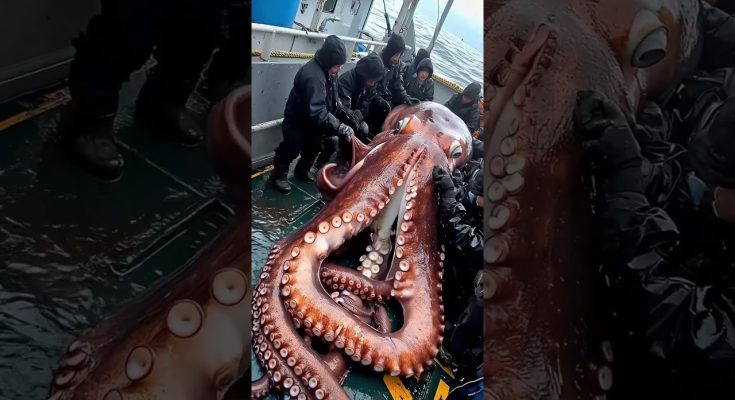The ocean has always been a place of intrigue, vast and unknown, a wilderness where humanity has ventured but not fully conquered. Over the centuries, fishermen have shared stories of colossal sea creatures, often dismissed as mere legends or exaggerated tales. Yet, recent discoveries have reignited the curiosity about these mysterious giants. The capture of giant sea monsters by fishermen has stirred the imagination, with tales of octopuses larger than boats, squid with tentacles reaching the ocean surface, and enigmatic creatures from the abyss that defy scientific explanation.
### The Unseen Giants of the Deep
The ocean is teeming with life, much of which remains unexplored. Covering more than 70% of the Earth’s surface, the deep-sea environment is a hostile and alien world, where creatures must adapt to extreme pressures, darkness, and cold. Some of the largest and most elusive creatures reside here, far beyond the reach of ordinary fishermen.
Among the most famous of these deep-sea giants are the giant squid (*Architeuthis*), colossal squid (*Mesonychoteuthis hamiltoni*), and giant octopus (*Enteroctopus dofleini*). These creatures have fascinated marine biologists and cryptozoologists alike for years, but only rarely have they been seen alive in their natural habitats.
#### Giant Squid: Legends of the Kraken
For centuries, sailors have told tales of the Kraken, a mythical sea monster said to be large enough to drag ships beneath the waves. Though it remained in the realm of folklore for much of human history, modern science has shown that these tales were likely inspired by real-life encounters with giant squid. Growing up to 43 feet long, giant squid are among the largest invertebrates on the planet.
In recent years, several fishermen have had the fortune—or misfortune—of pulling these enormous creatures from the depths. One such catch occurred off the coast of Spain, where a group of fishermen, expecting to reel in a typical haul of fish, found themselves grappling with a giant squid. With tentacles flailing and eyes as large as dinner plates, the squid was an imposing sight. This discovery, along with others like it, has led scientists to believe that the giant squid is far more common than previously thought, though it remains difficult to study due to its deep-sea habitat.
#### The Colossal Squid: Even Larger Than the Giant Squid
While the giant squid is impressive, the colossal squid may well be the true Kraken of the sea. This massive creature, which can grow up to 46 feet long and weigh more than 1,000 pounds, is the largest known invertebrate on Earth. Unlike the giant squid, which has been observed on rare occasions, the colossal squid is even more elusive. It resides in the deep, cold waters of the Southern Ocean around Antarctica, where few fishermen dare to venture.
One of the few known encounters with a colossal squid occurred in 2007 when a New Zealand fishing vessel caught a live specimen while fishing for Patagonian toothfish. The crew was astonished by the size and strength of the squid, which put up a fierce fight before finally being brought aboard. This particular squid was later studied by scientists, who were amazed by its sheer size and the unique adaptations it has for surviving in the extreme conditions of the deep ocean.
The colossal squid has large, sharp hooks on its tentacles, which it uses to grasp prey. Its eyes are among the largest of any animal, providing it with excellent vision in the pitch-black depths. Its body is also equipped with bioluminescent organs, which may help it attract prey in the dark waters of the deep sea. These adaptations have led some scientists to believe that the colossal squid is a top predator in its environment, capable of taking down large fish and even other squid.
### Octopuses: Masters of the Deep
Octopuses are among the most intelligent and adaptable creatures in the ocean. While most species are relatively small, there are some species of giant octopus that can grow to enormous sizes. The giant Pacific octopus (*Enteroctopus dofleini*), for example, can grow up to 16 feet across and weigh more than 150 pounds. However, there are reports of even larger octopuses, with some claims suggesting that individuals up to 30 feet across have been sighted.
These massive octopuses are incredibly strong and have been known to overpower large fish and even small sharks. They are also highly intelligent, capable of problem-solving and escaping from seemingly impossible situations. Fishermen have reported encounters with giant octopuses that have tangled their lines and nets, making them difficult to haul in.
One particularly famous story comes from Alaska, where a group of crab fishermen was surprised to find a giant Pacific octopus wrapped around their catch. The octopus had snuck into the crab pots, likely drawn by the smell of the bait, and was feasting on the crabs inside. When the fishermen tried to pull the octopus aboard, it resisted, using its powerful arms to cling to the boat. It took several men to finally wrestle the creature free.
### Deep-Sea Monsters: Myths or Reality?
While giant squid, colossal squid, and giant octopuses are some of the most well-known sea monsters, there are many other mysterious creatures lurking in the depths that have yet to be fully understood. Fishermen and sailors often report sightings of strange and unidentifiable creatures, sometimes referred to as “sea serpents” or “sea monsters.”
One such case occurred in 2020 when a group of deep-sea fishermen off the coast of Japan captured a strange, serpent-like creature that defied classification. The creature, which measured more than 15 feet long, had a long, sinuous body covered in iridescent scales and a head that resembled that of a dragon. The fishermen were baffled by their catch, and marine biologists have yet to determine what exactly the creature was. Some have speculated that it may have been a previously unknown species of deep-sea eel, while others believe it could be a new type of sea serpent.
Another intriguing case comes from Norway, where fishermen reported encountering a massive, jellyfish-like creature with tentacles stretching for miles. This creature, which has since been dubbed the “Norwegian Sea Monster,” has been spotted several times by fishermen in the region, though it has never been captured. Some scientists believe it may be a type of siphonophore, a colonial organism related to jellyfish that can grow to enormous lengths. However, without a specimen to study, its true identity remains a mystery.
### The Role of Fishermen in Discovering New Species
Fishermen play a crucial role in the discovery of new species and the study of deep-sea life. Many of the most significant marine discoveries have been made not by scientists, but by fishermen who have ventured into the unknown and brought back strange and unexpected creatures.
In many cases, fishermen have been the first to encounter species that were previously unknown to science. For example, the coelacanth, a prehistoric fish thought to have gone extinct millions of years ago, was rediscovered by a fisherman off the coast of South Africa in 1938. Similarly, the megamouth shark, a rare and elusive deep-sea shark, was first discovered when it became entangled in a fishing net off the coast of Hawaii in 1976.
Fishermen also provide valuable information to scientists about the distribution and behavior of deep-sea species. By sharing their observations and experiences, they help researchers better understand the biology and ecology of these mysterious creatures.
### Conservation and the Future of Deep-Sea Exploration
While the capture of giant sea monsters is certainly exciting, it also raises important questions about the impact of fishing on deep-sea ecosystems. Many deep-sea species are slow-growing and have low reproductive rates, making them vulnerable to overfishing and habitat destruction. In recent years, there has been growing concern about the effects of deep-sea trawling, which can destroy fragile habitats and deplete populations of rare and endangered species.
Conservation efforts are now underway to protect deep-sea ecosystems and the creatures that inhabit them. Marine protected areas have been established in some regions to safeguard critical habitats, and regulations have been put in place to limit the impact of fishing on deep-sea species.
At the same time, advances in technology are making it possible to explore the deep sea in ways that were once unimaginable. Remotely operated vehicles (ROVs) and submersibles are allowing scientists to venture into the depths and observe creatures in their natural habitats. These technologies are helping to shed light on the mysteries of the deep sea and uncover the secrets of the ocean’s most elusive giants.
### Conclusion: The Fascination with Giant Sea Monsters
The capture of giant sea monsters by fishermen continues to captivate the public’s imagination. These creatures, with their enormous size and mysterious origins, remind us of the vast unknown that still exists beneath the waves. While science has made great strides in understanding the ocean’s depths, there is still much to learn, and the potential for new discoveries remains immense.
As fishermen continue to explore the world’s oceans, we can expect more encounters with these elusive giants, further expanding our knowledge of the deep sea and the incredible creatures that call it home. Whether they are giant squid, colossal squid, or strange, unidentified monsters from the abyss, these sea creatures are a testament to the awe-inspiring power and mystery of the natural world.



